WARBIRDS RESOURCE GROUP > VIETNAM > F-104 STARFIGHTER > PREVIOUS PAGE
Operators/Users
Belgium operated F-104G and TF-104Gs. They served with four squadrons: 23 and 31 (fighter-bombers), 349 and 350 (interceptors), and finally an OCU unit. In total 101 SABCA-built F-104Gs and 12 TF-104G built by Lockheed were purchased (one
F-104G crashed before delivery). The Belgian Air Force operated the type from 14 February 1963 to 19 September 1983; some survivors were sent to Taiwan (23 aircraft) and Turkey (18 aircraft). Thirty-eight F-104G and three TF-104Gs were lost in accidents.
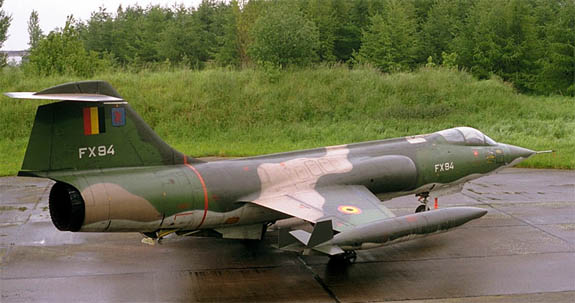
Belgian Air Force F-104 Starfighter. (Source: Unknown)
The RCAF, and later the unified Canadian Forces, operated 200 Canadian-built CF-104s and 38 dual-control trainer CF-104Ds (built by Lockheed) between 1962 and 1986. CF-104s were equipped with additional electronic equipment, with an RWR function, in the tail and under the nose. Losses were high, with around 110 crashes in Europe. Its heavy usage, mainly at low-level for bombing and reconnaissance missions was a major factor, while bad weather conditions contributed to almost 50% of the accidental losses. The airframes had an average of 6,000 flying hours when phased-out; triple that of Germany's F-104s. Surplus CF-104s and CF-104Ds were later transferred to Denmark, Norway and Turkey.

Canadian Armed Forces CF-104 Starfighter. (Photo: Unknown)
Taiwan operated a total of 281 aircraft funded by the Military Assistance Program; a mixture of new-build and surplus F-104A, B, D, G, J, DJ, RF-104G, and TF-104G were used. The Starfighter was phased out of Taiwanese service by 1997.
Denmark:
Denmark initially received 25 license-built Canadair F-104G and four Lockheed TF-104Gs under the Military Assistance Program. Surplus Canadian aircraft were transferred between 1972�74 (15 CF-104 and 7 CF-104D). A total of 51 Starfighters were operated by Denmark before their retirement in 1986. Fifteen surplus F-104Gs and three TF-104Gs were transferred to Taiwan in 1987.
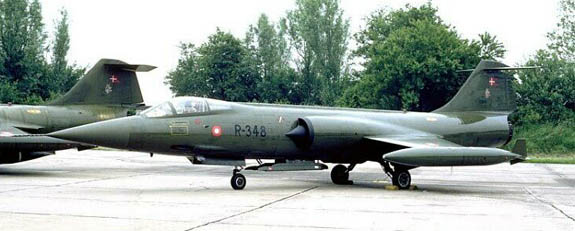
Danish F-104 Starfighter. (Photo: Unknown)
Germany received 916 F-104s, comprising 749 F/RF-104Gs, 137 TF-104Gs and 30 F-104Fs, forming the major combat equipment of both the Luftwaffe and Marineflieger. At its peak in the mid-1970s, the Luftwaffe operated five F-104 equipped fighter bomber wings, two interceptor wings and two tactical reconnaissance wings. The Marineflieger operated a further two wings of F-104s in the maritime strike and reconnaissance roles.
The Starfighter entered service with the Luftwaffe in July 1960, with deliveries continuing until March 1973, remaining in operational service until 16 October 1987, and continuing in use for test purposes until 22 May 1991.

Luftwaffe F-104G Starfighter. (Mika�l Restoux photo)
The Marineflieger initially used AS.30 command guidance missiles as anti-ship weapons, but these were replaced with the more sophisticated and longer-ranged radar-guided AS.34 Kormoran missile, allowing stand-off attacks to be carried out against enemy ships. German Starfighters proved to have an alarming accident rate. In German service, 292 of 916 Starfighters crashed, claiming the lives of 115 pilots.

Marineflieger F-104 Starfighter. (Source: Unknown)
Greece received 45 new-build F-104G and six TF-104s under the Military Assistance Program. These were supplemented by second-hand Starfighters passed on from other NATO air forces, including 79 from Germany, seven from the Netherlands and nine from Spain. The Starfighter entered Greek service in April 1964, equipping two wings, leaving service in March 1993.
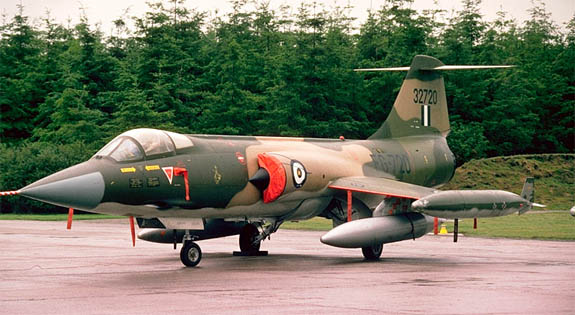
Greek F-104 Starfighter. (Source: Unknown)
In the Italian Air Force, the F-104 was a mainstay from the early 1960s until the end of the 20th century. The first flight for an Italian F-104G was a Lockheed-built aircraft, MM6501, on 9 June 1962; however, the first Fiat/Aeritalia-built example flew two years later on 5 October 1962. Italy initially received a total of 105 F-104G, 24 TF-104G and 20 RF-104Gs, becoming operational in March 1963. This fleet was later increased by the addition of 205 homebuilt F-104S aircraft and six ex-Luftwaffe TF-104Gs bringing the total number of aircraft operated to 360. In 1986 the AMI was the largest operator with eleven units flying the Starfighter operationally. Up to 1997, Italy lost 137 (38%) of its F-104s in 928,000 flying hours (14.7 aircraft every 100,000 hrs). The F-104 was officially retired from AMI service during a large ceremony at Pratica di Mare in 2004.

Italian Air Force F-104S Starfighter. (Italian Air Force photo)
The JASDF operated 210 F-104J air-superiority fighters and 20 dual-control trainer F-104DJs. Called Eiko ("Glory"), they served from October 1962 to 1986, losing only 36 examples in this time. Seven air-superiority squadrons used them: 201, 202, 203, 204, 205, 206, 207. Japanese F-104s faced Soviet aircraft during this long service; many were eventually converted to drones for aerial target practise.
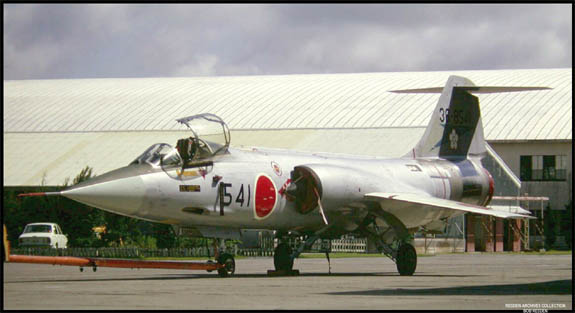
Japanese Air Self Defence Force F-104J Starfighter. (Redden Archives Collection)
Jordan received 29 F-104A and four F-104B aircraft delivered under the Military Assistance Program in 1967. Controlled by the United States these aircraft were moved temporarily to Turkey during the Arab�Israeli Six-Day War. Replaced by the Northrop F-5 and Dassault Mirage F1 by 1983, the survivors serve as airfield decoys.
Netherlands:
Netherlands operated European-built F-104s. A total of 138 Starfighters were delivered to the Koninklijke Luchtmacht (Royal Netherlands Air Force, or KLu). Many Dutch aircraft were transferred to Turkey

Royal Netherlands Air Force F-104 Starfighter. (Source: Unknown)
Norway received 18 surplus CF-104s and four CF-104Ds from Canada in 1974, the country had initially received 19 Canadair built F-104G and four TF-104G in 1963 under the Military Assistance Program. The F-104 was phased out of Norwegian service in winter 1982.
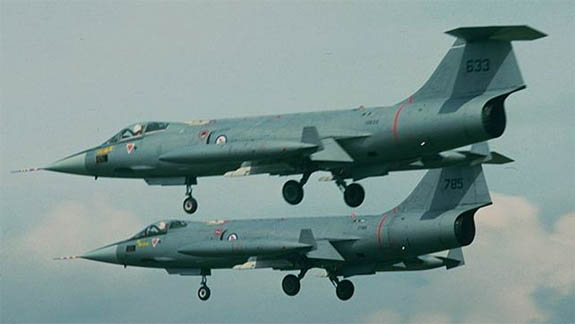
Norwegian F-104 Starfighters. (Source: Unknown)
Pakistan was the second country in Asia to get a supersonic aircraft when they acquired the F-104A and F-104B Starfighter in 1961 for the Pakistan Air Force and the first to take it into combat during 1965 India�Pakistan War. After the war, the remaining five PAF F-104s were grounded due to lack of spares resulting from the U.S. military embargo. They were replaced by French-made Dassault Mirage III fighters.
Spain:
The Spanish Air Force received their F-104s under the Military Assistance Program: 18 Canadair-built F-104Gs and three Lockheed-built TF-104Gs were delivered under MAP to Spain's Ejercito del Aire in 1965. These aircraft were transferred to Greece and Turkey when they were replaced by F-4 Phantoms in 1972. It is notable that no aircraft were lost through accidents during 17,000 hours of operational use in Spain although it should also be noted that the aircraft was used in its intended role of an interceptor and mainly in very good flying weather.
Turkey:
Turkey received 48 new-build F-104Gs and six TF-104Gs from Lockheed and Canadair production, funded under the Military Assistance Program, which were delivered from 1963, and directly purchased 40 new F-104S interceptors from Fiat in 1974�75. In addition, like Greece, Turkey received large numbers of surplus Starfighters from several NATO nations in the 1970s and 1980s, including 170 ex-German aircraft, 53 aircraft from the Netherlands and 52 from Canada. In total, Turkey received over 400 Starfighters from various sources, although many of these aircraft were broken up for spares without having been flown. The F-104 was finally retired from Turkish service in 1995.

Turkish F-104 Starfighter. (Source: Unknown)
Tactical Air Command, Air Defence Command & Air National Guard.

F-104C-5-LO Starfighter (S/N 56-0914). (U.S. Air Force photo)
Civil operators
NASA
Eleven F-104s (different versions) were operated by NASA between 1956 and 1994. Aircraft were used in support of the X-15 and XB-70 flight testing and were also used for astronaut training during various spaceflight programs. NASA F-104 aircraft were used to gather flight research data including aircraft handling characteristics, such as roll inertia coupling, and reaction control systems as used in the NF-104A and X-15. Space Shuttle thermal protection tiles were tested in flights aboard a Starfighter on a rig which simulated flight through rain. NASA's Starfighters flew many safety chase sorties in support of advanced research aircraft over the years, including the wingless lifting body aircraft. Neil Armstrong was one notable pilot who flew a NASA F-104.

NASA Starfighter #826 (N826NA). (Source: NASA)
Team based in Clearwater, Florida currently operate three Canadair CF-104 Starfighters, performing at air shows across the United States and Canada. Their CF-104s consist of a two-seat CF-104D Serial#:104632 (registered as N104RB), and two single-seat CF-104s Serial#s: 104850 (registered as N104RD) and 104759 (registered as N104RN). The aircraft were originally operated with the Royal Canadian Air Force and all later served with the Royal Norwegian Air Force before being imported into the U.S. in the early 1990s.
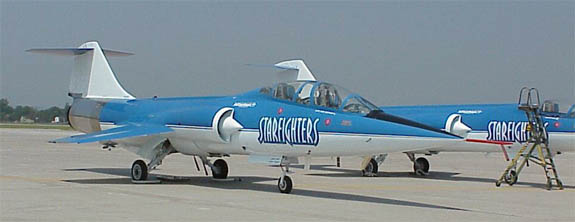
CF-104D of the Starfighters F-104 Demo Team. (Source: Unknown)
Another civilian Starfighter, called the F-104RB (for "Red Baron"), was used to set the low-level speed record in October 1977 by world-famous air racer Daryl Greenamyer. Greenamyer built his F-104 over a period of 12 years from parts scrounged from various places, including a "borrowed" J79-17/1 turbojet from a McDonnell Douglas F-4 Phantom, which developed over 2,000 pounds more thrust than the standard J79-19 engine. Greenamyer attacked the record at Mud Lake, near Tonapah, Nevada, and beat the previous low-level speed record by recording a top speed of 988.26 mph (1,590.41 km/h) after five passes over the dry lake. He remained supersonic for most of the 20-minute flight, and rarely rose much higher than 100 feet above the lake bed. Several months later, while practicing for an attempt on the world absolute altitude record, he was forced to eject when his landing gear failed to extend; a belly landing in the F-104 was considered too dangerous to attempt.
Sources:
Wikipedia: F-104 Starfighter
WARBIRDS RESOURCE GROUP > VIETNAM > F-104 STARFIGHTER > PREVIOUS PAGE
